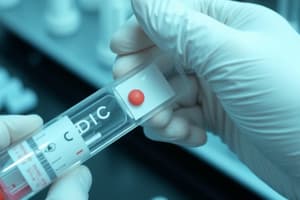Podcast
Questions and Answers
What intervention would the nurse include in the plan of care for a client with Disseminated Intravascular Coagulation (DIC)?
What intervention would the nurse include in the plan of care for a client with Disseminated Intravascular Coagulation (DIC)?
- Using a standard pain scale to evaluate and monitor pain
- Assessing level of consciousness (correct)
- Providing emotional support
- Applying cool compresses to painful joints
Which order from the healthcare provider would the nurse expect for a patient with chronic DIC?
Which order from the healthcare provider would the nurse expect for a patient with chronic DIC?
- Administer oxygen
- Administer heparin via continuous infusion pump (correct)
- Administer fresh frozen plasma
- Administer platelet infusion
Which diagnostic test does the nurse anticipate will be required for a client at risk for developing DIC?
Which diagnostic test does the nurse anticipate will be required for a client at risk for developing DIC?
- Electrolyte panel
- Coagulation studies (correct)
- CT scan
- X-rays
Which assessment findings would support the diagnosis of acute DIC? (Select all that apply)
Which assessment findings would support the diagnosis of acute DIC? (Select all that apply)
Which interventions will the nurse provide to support the client in pain with DIC? (Select all that apply)
Which interventions will the nurse provide to support the client in pain with DIC? (Select all that apply)
Which laboratory findings would support the diagnosis of DIC? (Select all that apply)
Which laboratory findings would support the diagnosis of DIC? (Select all that apply)
Which assessment finding supports the nursing diagnosis for potential hemorrhagic shock in a client with DIC?
Which assessment finding supports the nursing diagnosis for potential hemorrhagic shock in a client with DIC?
Which assessment is included in the health history portion for a client with DIC? (Select all that apply)
Which assessment is included in the health history portion for a client with DIC? (Select all that apply)
Which collaborative therapies might a client with DIC require? (Select all that apply)
Which collaborative therapies might a client with DIC require? (Select all that apply)
Which assessment findings would support the diagnosis of chronic DIC? (Select all that apply)
Which assessment findings would support the diagnosis of chronic DIC? (Select all that apply)
What conditions would the nurse include as possibly related to the development of DIC? (Select all that apply)
What conditions would the nurse include as possibly related to the development of DIC? (Select all that apply)
Which finding supports the diagnosis of DIC for a client?
Which finding supports the diagnosis of DIC for a client?
For which signs/symptoms should the nurse monitor a client in labor with HELLP syndrome?
For which signs/symptoms should the nurse monitor a client in labor with HELLP syndrome?
Flashcards
What is Disseminated Intravascular Coagulation (DIC)?
What is Disseminated Intravascular Coagulation (DIC)?
A serious condition where excessive clotting leads to depletion of clotting factors, causing bleeding.
What are some essential assessments for DIC?
What are some essential assessments for DIC?
Monitoring level of consciousness and evaluating for signs of hemorrhagic shock like oozing around IV sites.
What is the key diagnostic test for DIC?
What is the key diagnostic test for DIC?
Coagulation studies showing prolonged prothrombin time (PT) and decreased platelet count.
What are some pain management strategies for DIC patients?
What are some pain management strategies for DIC patients?
Signup and view all the flashcards
What are some supportive care measures for DIC?
What are some supportive care measures for DIC?
Signup and view all the flashcards
What are some laboratory findings indicative of DIC?
What are some laboratory findings indicative of DIC?
Signup and view all the flashcards
What are some conditions that can support a DIC diagnosis?
What are some conditions that can support a DIC diagnosis?
Signup and view all the flashcards
What conditions can precipitate DIC?
What conditions can precipitate DIC?
Signup and view all the flashcards
What is a significant risk factor for DIC?
What is a significant risk factor for DIC?
Signup and view all the flashcards
What is the primary focus of DIC treatment?
What is the primary focus of DIC treatment?
Signup and view all the flashcards
What are some common treatments for DIC?
What are some common treatments for DIC?
Signup and view all the flashcards
What are some early signs of acute DIC?
What are some early signs of acute DIC?
Signup and view all the flashcards
What symptom is often present with internal bleeding in DIC?
What symptom is often present with internal bleeding in DIC?
Signup and view all the flashcards
Study Notes
Disseminated Intravascular Coagulation (DIC) Assessment and Management
- DIC is a serious condition characterized by excessive clotting leading to depletion of clotting factors, causing bleeding.
- Essential assessments include monitoring level of consciousness and evaluating for signs of hemorrhagic shock such as oozing around IV sites.
- Key diagnostic test for DIC is coagulation studies showing prolonged prothrombin time (PT) and decreased platelet count.
Interventions and Supportive Care
- Pain management strategies include using a standard pain scale, applying cool compresses to painful areas, and handling extremities gently.
- Providing emotional support and encouraging frequent turning and coughing are also important for overall care.
- Collaborative therapies may involve oxygen administration, monitoring for intracranial bleeding, and assessing organ damage.
Laboratory Findings
- Elevated fibrin degradation products, decreased platelet count, and presence of schistocytes are indicative of DIC.
- DIC diagnosis may also be supported by a history of conditions such as abnormal bleeding episodes, recent spontaneous abortions, and known malignancies.
Risk Factors and Related Conditions
- DIC can be precipitated by fetal demise, septic abortion, and preeclampsia, often leading to systemic complications.
- Prolonged retention of a nonviable fetus is a significant risk for DIC due to consumption of maternal clotting factors.
Treatments and Medications
- Treatment primarily focuses on addressing the underlying cause of DIC, replacing coagulation factors, and may involve administering heparin.
- Fresh frozen plasma and platelet infusions are commonly used to replace deficient blood components; however, warfarin (Coumadin) is contraindicated in DIC.
- Continuous monitoring of vital signs, including urinary output and signs of internal bleeding, is crucial.
Clinical Manifestations
- Early signs of acute DIC include unexpected bleeding, petechiae, and signs of organ dysfunction such as hematuria or focal ischemia.
- Symptoms such as increasing abdominal girth can suggest internal bleeding, necessitating immediate evaluation and intervention.
Educational Considerations
- Nurses should provide education on recognizing signs of DIC and the importance of rapid reporting of symptoms to healthcare providers.
- Understanding the implications of lab tests, such as prolonged PT, is essential in predicting and managing DIC complications.
Studying That Suits You
Use AI to generate personalized quizzes and flashcards to suit your learning preferences.
Description
This quiz consists of practice questions focused on Disseminated Intravascular Coagulation (DIC) tailored for nursing care. Test your knowledge regarding the interventions necessary for promoting tissue perfusion in patients with DIC. Perfect for nursing students preparing for exams.




